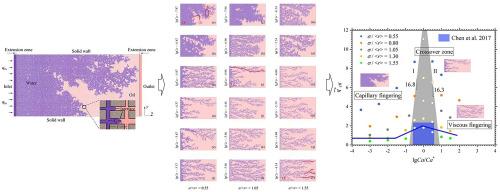Quantifying the crossover from capillary fingering to viscous fingering in heterogeneous porous media
IF 3.6
引用次数: 0
Abstract
Studying immiscible fluid displacement patterns can provide a better understanding of displacement processes within heterogeneous porous media, thereby helping improving oil recovery and optimizing geological CO2 sequestration. As the injection rate of water displacing oil increases and the displacement pattern transits from capillary fingering to viscous fingering, there is a broad crossover zone between the two that can adversely affect the oil displacement efficiency. While previous studies have utilized phase diagrams to investigate the influence of the viscosity ratio and wettability of the crossover zone, fewer have studied the impact of rock heterogeneity. In this study, we created pore network models with varying degrees of heterogeneity to simulate water flooding at different injection rates. Our model quantifies capillary and viscous fingering characteristics while investigating porous media heterogeneity's role in the crossover zone. Analysis of simulation results reveals that a higher characteristic front flow rate within the crossover zone leads to earlier breakthrough and reduced displacement efficiency. Increased heterogeneity in the porous media raises injection-site pressure, lowers water saturation, and elevates the characteristic front flow rate, thereby expanding the extent of crossover zone.

定量非均质多孔介质中从毛细指法到粘性指法的交叉
研究非混相流体驱替模式可以更好地理解非均质多孔介质内的驱替过程,从而有助于提高采收率和优化地质CO2封存。随着水驱油注入速度的增加,驱替模式从毛细指动过渡到粘滞指动,两者之间存在较大的交叉区,对驱油效率产生不利影响。以往的研究都是利用相图来研究交叉带黏度比和润湿性的影响,但对岩石非均质性影响的研究较少。在这项研究中,我们创建了不同非均质程度的孔隙网络模型,以模拟不同注入速度下的水驱。我们的模型量化了毛细管和粘性指进特征,同时研究了多孔介质非均质性在交叉区的作用。仿真结果分析表明,交叉区特征锋面流量越大,越早突破,驱替效率越低。多孔介质非均质性的增加提高了注入点压力,降低了含水饱和度,提高了特征前缘流速,从而扩大了交叉区的范围。
本文章由计算机程序翻译,如有差异,请以英文原文为准。
求助全文
约1分钟内获得全文
求助全文

 求助内容:
求助内容: 应助结果提醒方式:
应助结果提醒方式:


